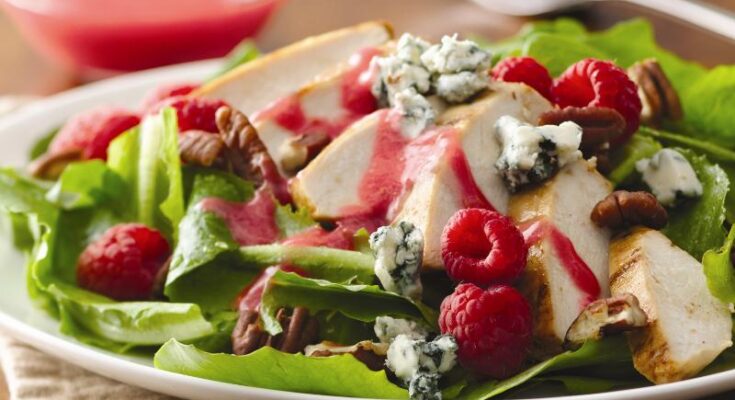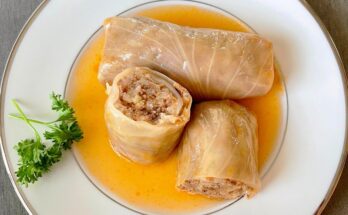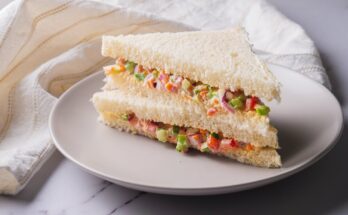Raspberry Vinaigrette Recipe: Raspberry vinaigrette is a sweet, tangy, and slightly tart dressing made primarily from fresh or frozen raspberries, vinegar, and oil. It’s the kind of condiment that adds a splash of color and a burst of flavor to just about any salad. Unlike your typical vinaigrettes, this fruity version adds a naturally sweet and zesty twist that pairs well with both greens and proteins.
Think of it as the perfect blend of fruity brightness and acidic bite. It’s ideal for people looking to jazz up their salad game without relying on heavy, creamy dressings. And if you’re trying to eat healthier, raspberry vinaigrette is typically lower in calories and loaded with antioxidants thanks to the berries.
Why It’s a Favorite Dressing
So, why is raspberry vinaigrette a go-to for so many? For starters, it’s versatile. You can drizzle it over a spinach and goat cheese salad, use it as a glaze for grilled chicken, or even splash it over roasted veggies for an extra punch. It’s not just for health nuts or salad enthusiasts either—it’s universally appealing thanks to its balance of sweet and tart flavors.
Moreover, it’s incredibly easy to make. In under 10 minutes, you can whip up a fresh batch at home with just a few pantry staples and some raspberries. Store-bought versions are convenient, sure, but homemade raspberry vinaigrette lets you control the sweetness, texture, and overall flavor without any additives or preservatives.
Ingredients You’ll Need
Fresh vs Frozen Raspberries
When it comes to making raspberry vinaigrette, you can use either fresh or frozen raspberries. Fresh raspberries offer a vibrant flavor and a juicier profile, especially when they’re in season. They also make the dressing look and taste extra fresh. But frozen raspberries? They work just as well—and they’re available year-round.
If you’re using frozen berries, just let them thaw a bit before blending. Frozen raspberries can sometimes be slightly more tart, so you may need to adjust the sweetener to balance the flavor.
Additional Flavor-Boosting Ingredients
Here’s your essential ingredient list:
- 1 cup fresh or thawed raspberries
- 2 tablespoons red wine vinegar or apple cider vinegar
- 1 teaspoon Dijon mustard (for a touch of zing and emulsification)
- 2–3 tablespoons honey or maple syrup (adjust based on taste)
- 1/3 cup olive oil or avocado oil
- Salt and black pepper to taste
Optional add-ins:
- 1 teaspoon poppy seeds for texture
- 1 small garlic clove, minced, for added depth
- A squeeze of lemon juice for extra acidity
These ingredients strike a perfect balance between sweet, tart, and savory. You’re not locked into this list—feel free to tweak it according to your taste buds or dietary needs.
Step-by-Step Raspberry Vinaigrette Recipe
Step 1: Prepare the Ingredients
Before you do anything, gather all your ingredients and measure them out. Wash the raspberries if they’re fresh. If they’re frozen, thaw them in a bowl for a few minutes. Mince the garlic if you’re using it, and get your vinegar and oil ready.
This step may seem basic, but having everything prepped makes the blending process a breeze. It’s the kind of mise en place that’ll save you time and avoid the mess.
Step 2: Blend to Perfection
Toss the raspberries, vinegar, mustard, and sweetener (honey or maple syrup) into a blender or food processor. Blend until everything is smooth and emulsified. Slowly drizzle in the oil while blending to create a creamy, well-mixed vinaigrette.
Blending slowly with the oil is key—it helps the ingredients bind together instead of separating after a few minutes. You’ll notice the color turn a gorgeous pinkish-red, and the texture will be silky with a bit of body.
Step 3: Strain and Store
Once the mixture is blended, you can choose to strain it through a fine mesh sieve to remove the raspberry seeds. This step is totally optional—some people love the texture, while others prefer a smoother finish.
After straining, pour the vinaigrette into a clean mason jar or bottle. Seal it tight and refrigerate. It’ll stay fresh for up to one week. Just give it a good shake before each use since natural separation can occur.
Tips for the Perfect Vinaigrette
Balancing Sweetness and Acidity
Getting the right balance of sweet and acidic flavors is what separates an average vinaigrette from an unforgettable one. Raspberries are naturally tart, so you need something to mellow that sharpness—enter the sweeteners. Honey and maple syrup are top choices because they blend smoothly and bring an earthy sweetness that complements the berries beautifully.
Start with a little sweetener and taste as you go. Everyone’s palate is different—some like it more tangy, while others prefer it on the sweeter side. The same goes for the vinegar. Red wine vinegar adds a deep, robust flavor, while apple cider vinegar lends a milder, fruity tang. Try experimenting with balsamic vinegar if you’re aiming for a more complex, caramel-like undertone.
If your dressing ever turns out too tart, simply add more oil or sweetener to soften the edge. A small pinch of salt can also work wonders by amplifying all the flavors without making it taste salty.
Choosing the Right Oil
Oil might not be the star of this vinaigrette, but it plays a big supporting role. The wrong oil can totally overpower the fresh, fruity flavors, while the right one blends in seamlessly and enhances the richness.
Extra virgin olive oil is a classic pick—it’s smooth, slightly peppery, and works well with fruity profiles. However, it can sometimes be a bit too bold. In that case, go with a neutral oil like avocado oil, grapeseed oil, or even a light canola oil. These let the raspberries shine without competing for attention.
The key is to choose a high-quality oil that has a clean taste. And remember, you don’t want to dump it all in at once. Slowly adding the oil while blending helps emulsify the dressing, giving it a creamy, cohesive texture rather than a separated mess.
Creative Ways to Use Raspberry Vinaigrette
On Salads
Let’s be honest—this is where raspberry vinaigrette really shows off. It’s the MVP of fruity salad dressings. It pairs beautifully with leafy greens like arugula, baby spinach, and romaine. But where it truly shines is in salads with contrasting elements—think nuts, cheeses, and fruits.
Here are some killer salad combos:
- Spinach + goat cheese + walnuts + strawberries
- Mixed greens + feta + almonds + mandarin oranges
- Arugula + blue cheese + pecans + grilled chicken
The tangy sweetness of the vinaigrette balances the richness of cheese and the crunch of nuts perfectly. It’s a flavor explosion in every bite.
And don’t be afraid to get creative. Add some quinoa, roasted veggies, or grilled tofu to make it a meal-worthy salad. The dressing holds up well and enhances a variety of textures and tastes.
As a Marinade or Glaze
Raspberry vinaigrette isn’t just for salads—it can work magic as a marinade or glaze too. Its acidity helps tenderize meats, while the berry sweetness creates a sticky, caramelized finish when grilled or roasted.
Try marinating chicken breasts, pork chops, or even salmon in raspberry vinaigrette for at least 30 minutes before cooking. You’ll get a juicy, flavorful result with a beautiful reddish glaze.
As a glaze, brush it on grilled vegetables or roasted carrots in the last few minutes of cooking. It adds a sweet, tangy pop that makes even the simplest side dish feel gourmet. It’s also great drizzled over grain bowls, wraps, or used as a dipping sauce for crusty bread.
Storing and Shelf Life of Homemade Raspberry Vinaigrette
How Long Does It Last?
One of the best things about homemade raspberry vinaigrette is how fresh and vibrant it tastes compared to store-bought versions. But freshness comes with a shorter shelf life. Typically, this vinaigrette will last about 5 to 7 days in the refrigerator when stored properly in an airtight container or glass mason jar.
Because there are no preservatives in homemade dressings, you’ll want to give it a quick visual and sniff test before using after a few days. If it smells sour or looks separated beyond saving, it’s time to whip up a new batch. A great tip? Make small batches you can use up quickly to avoid waste.
Storage Tips
To keep your vinaigrette tasting fresh:
- Use a glass container: Glass helps preserve flavor and prevents reactions that can occur with plastic.
- Seal it tight: Exposure to air shortens shelf life and dulls flavor.
- Shake before using: Natural separation will happen, especially with oil-based dressings. A quick shake or stir brings it back together.
Also, never double-dip with a used spoon—it introduces bacteria that can spoil the vinaigrette faster. Always pour out what you need and store the rest.
Health Benefits of Raspberry Vinaigrette
Nutritional Highlights
Raspberry vinaigrette isn’t just tasty—it’s surprisingly nutritious when made at home. Let’s break it down:
- Raspberries: Packed with antioxidants, fiber, and vitamin C. They help fight inflammation and support immunity.
- Vinegar: Especially apple cider vinegar, can aid digestion and help balance blood sugar.
- Olive oil: A heart-healthy fat loaded with omega-3s and anti-inflammatory compounds.
- Honey or maple syrup: More natural sweeteners that offer trace minerals and avoid refined sugars.
This vinaigrette is generally low in calories and sugars, especially when compared to creamy store-bought options. It’s a great choice if you’re watching your diet but still want maximum flavor.
Perfect for Special Diets
Raspberry vinaigrette can be easily tailored to fit almost any diet. It’s:
- Gluten-free
- Dairy-free
- Vegan (if using maple syrup instead of honey)
- Paleo and Whole30-friendly with slight tweaks
By controlling the ingredients yourself, you get peace of mind knowing exactly what’s going into your body.
Common Mistakes to Avoid
Overpowering the Dressing
One of the most common issues people face is using too much vinaigrette. Raspberry vinaigrette is bold—it doesn’t need to drown your salad. A light drizzle is usually more than enough. Start small; you can always add more.
Another mistake? Using overly tart or underripe raspberries. They’ll make your vinaigrette harsh and overly acidic. Taste your berries first—if they’re super tart, just bump up the sweetener a bit to keep things balanced.
Skipping the Emulsification
This is a big one: If you don’t emulsify properly, your oil and vinegar will separate almost instantly. It won’t just look unappetizing—it’ll taste uneven too. Blend slowly while drizzling in the oil to create a smooth, creamy consistency that doesn’t split after five minutes.
Lastly, don’t forget to taste and adjust. The best vinaigrettes are customized to your palate. A little tweak here and there can turn a good dressing into a spectacular one.
FAQs about Raspberry Vinaigrette Recipe
1. Can I freeze raspberry vinaigrette?
Freezing isn’t recommended as it can change the texture once thawed. It’s best enjoyed fresh or within a week from the fridge.
2. What’s the best vinegar to use?
Red wine vinegar and apple cider vinegar are top picks, but balsamic can add a rich, tangy-sweet twist.
3. Can I use other berries instead of raspberries?
Absolutely! Try blackberries or strawberries for a similar fruity profile. Just remember to adjust the sweetness accordingly.
4. Is raspberry vinaigrette keto-friendly?
It can be if you use a keto-approved sweetener like erythritol or monk fruit instead of honey or maple syrup.
5. How can I thicken my vinaigrette?
Add a touch of Dijon mustard or blend in a few extra raspberries. Both add thickness and depth to the flavor.
Conclusion
Homemade raspberry vinaigrette is the perfect blend of vibrant flavor, nutrition, and versatility. Whether you’re dressing up your favorite salad, glazing meats, or adding a fruity twist to your next bowl, this easy recipe brings gourmet taste to your kitchen without any complicated steps. With fresh ingredients and a bit of love, you can say goodbye to store-bought bottles and hello to bold, fresh flavor every time.



